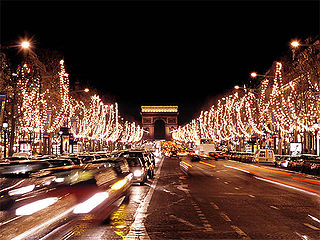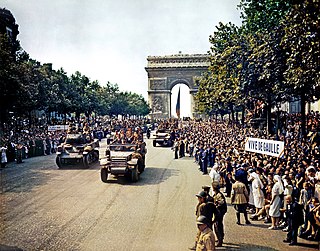
The Arc de Triomphe de l'Étoile, often called simply the Arc de Triomphe, is one of the most famous monuments in Paris, France, standing at the western end of the Champs-Élysées at the centre of Place Charles de Gaulle, formerly named Place de l'Étoile—the étoile or "star" of the juncture formed by its twelve radiating avenues. The location of the arc and the plaza is shared between three arrondissements, 16th, 17th (north), and 8th (east). The Arc de Triomphe honours those who fought and died for France in the French Revolutionary and Napoleonic Wars, with the names of all French victories and generals inscribed on its inner and outer surfaces. Beneath its vault lies the Tomb of the Unknown Soldier from World War I.

The Place Charles de Gaulle, historically known as the Place de l'Étoile, is a large road junction in Paris, France, the meeting point of twelve straight avenues including the Champs-Élysées. It was renamed in 1970, following the death of President Charles de Gaulle. It is still often referred to by its original name; the nearby Métro and RER station retains the designation Charles de Gaulle–Étoile. Paris's Axe historique cuts through the Arc de Triomphe, which stands at the centre of the Place Charles de Gaulle.

The Axe historique refers to a straightly aligned series of thoroughfare streets, squares, monuments and buildings that extend from the centre of Paris, France, to the west-northwest of the city. It is also known as the Voie Triomphale.

The Avenue des Champs-Élysées is an avenue in the 8th arrondissement of Paris, France, 1.9 kilometres (1.2 mi) long and 70 metres (230 ft) wide, running between the Place de la Concorde in the east and the Place Charles de Gaulle in the west, where the Arc de Triomphe is located. It is known for its theatres, cafés, and luxury shops; as the finish of the Tour de France cycling race; and for its annual Bastille Day military parade. The name is French for the Elysian Fields, the place for dead heroes in Greek mythology. It has been described as the "most beautiful avenue in the whole world".

La Défense is a major business district in France's Paris metropolitan area, 3 kilometres (1.9 mi) west of the city limits. It is located in Île-de-France region's department of Hauts-de-Seine in the communes of Courbevoie, La Garenne-Colombes, Nanterre, and Puteaux.

The 8th arrondissement of Paris is one of the 20 arrondissements of the capital city of France. In spoken French, the arrondissement is colloquially referred to as le huitième.

George V is a station on Line 1 of the Paris Métro, under the Champs-Élysées.

The liberation of Paris was a battle that took place during World War II from 19 August 1944 until the German garrison surrendered the French capital on 25 August 1944. Paris had been occupied by Nazi Germany since the signing of the Armistice of 22 June 1940, after which the Wehrmacht occupied northern and western France.

Porte Maillot is a station on Paris Métro Line 1. It is connected to the station ‹See TfM›Neuilly–Porte Maillot on the RER C and RER E, as well as a stop of tramway line T3b. The station in its current form opened in 1937, replacing the original Porte Maillot station that opened in 1900 as the original terminus of Line 1. It serves the Palais des Congrès and has exits towards Neuilly-sur-Seine. It is located close to the Bois de Boulogne.

The Avenue Foch is an avenue in the 16th arrondissement of Paris, France, named after World War I Marshal Ferdinand Foch in 1929. It was previously known as the Avenue du Bois de Boulogne. It is one of the most prestigious streets in Paris, as well as one of the most expensive addresses in the world, home to many grand city palaces, including ones belonging to the Onassis and Rothschild families. The Rothschilds once owned numbers 19–21.

Charles de Gaulle–Étoile station is a station on Line 1, Line 2 and Line 6 of the Paris Métro, as well as on Île-de-France's commuter rail RER A. It lies on the border of the 8th, 16th and 17th arrondissements of Paris. Originally called simply Étoile, after its location at Place de l'Étoile, it took on the additional name of President Charles de Gaulle in 1970.

Champs-Élysées–Clemenceau is a station on Line 1 and Line 13 of the Paris Métro in the 8th arrondissement.

The following is a list of the 660 names inscribed under the Arc de Triomphe, in Paris. Most of them represent generals who served during the French First Republic (1792–1804) and the First French Empire (1804–1815). Underlined names signify those killed in action. Additionally, the names of specific armies are listed, grouped together by the four compass facades of the arch: North, East, South and West.

Tourism in Paris is a major income source. Paris received 12.6 million visitors in 2020, measured by hotel stays, a drop of 73 percent from 2019, due to the COVID-19 pandemic. The number of foreign visitors declined by 80.7 percent. Museums re-opened in 2021, with limitations on the number of visitors at a time and a requirement that visitors wear masks.

The Tunnel de l'Étoile is a tunnel in Paris. In the past it was a road tunnel, but since 2020 it is a bicycle tunnel. It links the Avenue des Champs-Élysées to the Avenue de la Grande Armée, passing underneath the Place Charles de Gaulle and the Arc de Triomphe. It is around 400 metres long.

Bernard-Gabriel Seurre or Seurre the Elder was a French sculptor. His younger brother Charles Émile Seurre (1798–1858) was also a sculptor.
This article presents the main landmarks in the city of Paris within administrative limits, divided by its 20 arrondissements. Landmarks located in the suburbs of Paris, outside of its administrative limits, while within the metropolitan area are not included in this article.

The Jardin des Champs-Élysées is a public park located in the 8th arrondissement of Paris. It occupies 13.7 hectares, and is located on both sides of the Avenue des Champs-Élysées between the Place de la Concorde on the east and the Rond-point des Champs-Élysées on the west and between Avenue Gabriel to the north and the Seine to the south. It includes within its boundaries the Grand Palais and the Petit Palais, as well as a theater and other buildings. It was one of the first parks in the city, laid out by André Le Notre in 1667, and was the site of the Paris International Exposition of 1855 and an important part of the Paris Universal Exposition of 1900, for which the Grand Palais and Petit Palais were created.

La Défense de Paris is a bronze statue by French sculptor Louis-Ernest Barrias. It commemorates the French dead from the Siege of Paris in 1870–71, during the Franco-Prussian War. The sculpture group was unveiled to the west of Paris on 12 October 1883, erected on an existing plinth that had previously supported a bronze sculpture of Napoleon by Charles Émile Seurre, alongside the crossroads between Courbevoie and Puteaux. The location became the La Défense roundabout, but the statue was later removed. The surrounding area was subsumed into Paris as the city expanded later in the 19th and in the 20th centuries; the area became known as La Défense after the statue. The statue was removed to a new location about 1965, and then moved several times before it was placed at its current location near the Arche de la Défense in 2017.

The following is a list of the 158 battles inscribed on the Arc de Triomphe in Paris, which were fought by the French First Republic and the First French Empire between 1792 and 1815:




















